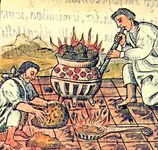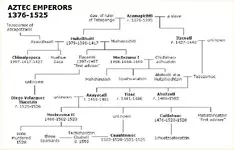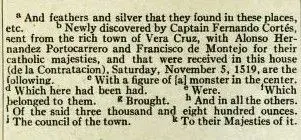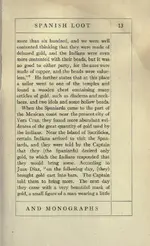You are using an out of date browser. It may not display this or other websites correctly.
You should upgrade or use an alternative browser.
You should upgrade or use an alternative browser.
Location of Aztec Gold
- Thread starter Salvor6
- Start date
airborne1092
Hero Member
@ piegrande -
I did not sense you intended a slight or personal attack. My math is at best, shoddy and my understanding of precious metals, esp. in the ancient or historical parlance is nil.
Thank you for setting me straight. I take your (correct) mathematics to mean the properties of said amount of gold mined in the US since 1970 to be physical, considerably less.
The web site I referenced in the link, listed the gold production in 5 year segments. I simply took the quantity at every 5 year mark, and multiplied it >back< to the last 5 year mark, as if to assume that 5 year mark total was always the most generous year. The end-total I simply rounded down. Same basic method as one might dead-reckon through the forest, alternating his transits around trees placed in the pathway to average ones pace-count at the end while staying the course, literally. It was only after I posted my (albeit, sophomoric) argument did I find info relating to 'specific gravity.' As you can imagine, I fortified myself, in preparation for the royal flaming I figured would ensue, from the die-hard Aztec gold hunters I had just exposed my backside to!
My overall end state was of course to illustrate that, it would have take many generations and a whole heck of a lot of gold to substantiate the claims of the conquistadors. Simply stated, I do not believe there was that much gold as indicated, based on the primitive techniques used to extract and process the PMs they're said to have possessed.
Piegrande - Thank you for the lesson and for keeping my math 'honest!' -


Señor de la Mancha - for your hard work and diligence in research, and for keeping a neophyte like myself in line -


I did not sense you intended a slight or personal attack. My math is at best, shoddy and my understanding of precious metals, esp. in the ancient or historical parlance is nil.
Thank you for setting me straight. I take your (correct) mathematics to mean the properties of said amount of gold mined in the US since 1970 to be physical, considerably less.
The web site I referenced in the link, listed the gold production in 5 year segments. I simply took the quantity at every 5 year mark, and multiplied it >back< to the last 5 year mark, as if to assume that 5 year mark total was always the most generous year. The end-total I simply rounded down. Same basic method as one might dead-reckon through the forest, alternating his transits around trees placed in the pathway to average ones pace-count at the end while staying the course, literally. It was only after I posted my (albeit, sophomoric) argument did I find info relating to 'specific gravity.' As you can imagine, I fortified myself, in preparation for the royal flaming I figured would ensue, from the die-hard Aztec gold hunters I had just exposed my backside to!
My overall end state was of course to illustrate that, it would have take many generations and a whole heck of a lot of gold to substantiate the claims of the conquistadors. Simply stated, I do not believe there was that much gold as indicated, based on the primitive techniques used to extract and process the PMs they're said to have possessed.
Piegrande - Thank you for the lesson and for keeping my math 'honest!' -



Señor de la Mancha - for your hard work and diligence in research, and for keeping a neophyte like myself in line -



Real de Tayopa Tropical Tramp
Gold Member
- Joined
- Nov 8, 2004
- Messages
- 14,582
- Reaction score
- 11,947
- Golden Thread
- 0
- Location
- Alamos,Sonora,Mexico
- Primary Interest:
- All Treasure Hunting
Sheehs, I shudder to think of working around smelting in bare feet as they are doing.. I once had a synthetic shirt literally melt and stick to my tummy from the radiant heat. Very, very uncomfortable since you cannot get rid of the super heated material. An example is the hot glue guns. Yes, it left a few scars.
Don Jose de La Mancha
Don Jose de La Mancha
Real de Tayopa Tropical Tramp
Gold Member
- Joined
- Nov 8, 2004
- Messages
- 14,582
- Reaction score
- 11,947
- Golden Thread
- 0
- Location
- Alamos,Sonora,Mexico
- Primary Interest:
- All Treasure Hunting
good morning airborne: thank you for the coffee, it was needed this cooold morning, temp at my computer is about 15 C ( 60 F), brrrr.
Regarding the Aztecs production capacity, may I remind you that they had the pick of 'extremely rich ores and placers' and so didn't need a huge production.
Up a Tayopa for example, they list 610 mule loads of Au, and 1200 bars of Silver, among others, in the main depository. A mule load at that altitude and type of terrain runs approx 90 kilos. Obviously the fineness is presently still unknown. A crude estimate of these Dore' bars is 60 - 70 % fine.
Imagine what the various mines around Mexico city were capable of producing in those days.
Drool
Don Jose de La Mancha
Regarding the Aztecs production capacity, may I remind you that they had the pick of 'extremely rich ores and placers' and so didn't need a huge production.
Up a Tayopa for example, they list 610 mule loads of Au, and 1200 bars of Silver, among others, in the main depository. A mule load at that altitude and type of terrain runs approx 90 kilos. Obviously the fineness is presently still unknown. A crude estimate of these Dore' bars is 60 - 70 % fine.
Imagine what the various mines around Mexico city were capable of producing in those days.
Drool
Don Jose de La Mancha
coazon de oro
Bronze Member
Those "Hornos", or wood burning clay ovens are still being made and used today.
One of my neighbors has one in his ranch, except his is covered with cement. You can google horno and go to images to see several.
Homar
One of my neighbors has one in his ranch, except his is covered with cement. You can google horno and go to images to see several.
Homar
Thank you for understanding, airborn, that I was only showing the correct math, with no intention of offending at all.
In my village, coazon, is a small bakery that still uses something like that oven. I cannot say they haven't used some sort of cement over the years to make it stronger. But, just before the Day of the Dead, they crank out muertitos, little things of bread with a light frosting on them, in the shape of little men. They sell as fast as they can bake them.
By the way, here is the list of Emperors, with minimal genealogy, in the attached photo.
In my village, coazon, is a small bakery that still uses something like that oven. I cannot say they haven't used some sort of cement over the years to make it stronger. But, just before the Day of the Dead, they crank out muertitos, little things of bread with a light frosting on them, in the shape of little men. They sell as fast as they can bake them.
By the way, here is the list of Emperors, with minimal genealogy, in the attached photo.
Attachments
somehiker
Silver Member
- Joined
- May 1, 2007
- Messages
- 4,365
- Reaction score
- 6,435
- Golden Thread
- 0
- Primary Interest:
- All Treasure Hunting
"How much gold have we mined commercially in the US?
Roughly 4,600 tons since 1970. "
One thing to keep in mind,that modern gold production figures cannot be used to estimate quantities of gold or silver recovered and utilized in ancient times.
Human history on earth,especially the history of human civilizations which placed some degree of value upon gold/silver,is infinitesimal compared to the geological history of the planet itself.I would think it reasonable that as each civilization developed a use for the metals,it's population would first gather what was visible on the surface or in waterways as placer deposits as well as in exposed viens or pockets.It is my belief that the amounts would have been considerable,perhaps far greater than we will ever know.Mining for pure metal would have followed,with the collection of ore and development of refining techniques only a solution to the depletion of the millions of years of accumulated surface deposits.
A brief history of gold on this page:
http://www.onlygold.com/tutorialpages/historyfs.htm
Regards:SH.
Roughly 4,600 tons since 1970. "
One thing to keep in mind,that modern gold production figures cannot be used to estimate quantities of gold or silver recovered and utilized in ancient times.
Human history on earth,especially the history of human civilizations which placed some degree of value upon gold/silver,is infinitesimal compared to the geological history of the planet itself.I would think it reasonable that as each civilization developed a use for the metals,it's population would first gather what was visible on the surface or in waterways as placer deposits as well as in exposed viens or pockets.It is my belief that the amounts would have been considerable,perhaps far greater than we will ever know.Mining for pure metal would have followed,with the collection of ore and development of refining techniques only a solution to the depletion of the millions of years of accumulated surface deposits.
A brief history of gold on this page:
http://www.onlygold.com/tutorialpages/historyfs.htm
Regards:SH.
RELICDUDE07
Bronze Member
- Joined
- Oct 2, 2007
- Messages
- 2,128
- Reaction score
- 54
- Golden Thread
- 0
- Location
- Pascagoula Ms.
- Detector(s) used
- minelab exp.
airborne1092 said:I've read this thread, and want to say up front, In so far as the Aztecs, I know squat - except what the movies tell me.
However, I don't believe you need to know the Aztecs, to know where all that gold is. Several thoughts come to mind;
The picture of natives collecting gold from the river is interesting. It would however be very tedious and not net you a whole heck of a lot. Most if not all that would be placer type powder and flakes.
The picture would be consistent with my next thought, that I disagree with some here on one point - You do need some level of understanding of metallurgy, to mine and process gold and silver. Hard-rock mining? how are you going to accomplish this, without iron or bronze? Even bronze is fairly soft. Certainly wood won't break rock very well. When you smelt and homogenize the gold or silver, how the heck are you going to do that without a bronze or iron cauldron? A stone cauldron you say? How are you going to carve that without strong metal? A natural rock bowl for a cauldron? That would be very tedious, my friend. IMO to process these metals, you need to first have a grasp on iron and bronze craft with which to make tools. BTW, gold melts at 1850 F. The Aztecs stored their gold in places like AZ, UT or NM? That's a stretch. How many people would it take to carry tons of gold and silver that distance? Way too many, IMO.
Here's the conclusion I came to. The Spaniards were explorers, commissioned by the king/queen of Spain. That was their livelihood. What was their first thought, when they reached the shores of central America and were met by people wearing deer-skin thongs and living in adobe huts? Oh crap - these folks are pretty poor! Of course they're going to make up some spectacular story about how the pyramids were shod with gold! everyone wore gold, even the commoner. Sure, perhaps most had ornamental gold, but as one previous poster said, it was whatever they found in the rivers or in the caves. It was nothing substantial. "Oh! Yes Sir! More gold than you can imagine!" "Of course we need to go back, this is but a sample of what we found. There was too much to bring back all in one trip!" Wouldn't YOU want to keep your well financed job and your reputation? Of course you would! Then, upon hearing the initial stories, more explorers came, and failed to find these magical pyramids clad in gold, so the locals were tortured to get an appropriate answer. Wasn't this about the same time as the Spanish inquisitions? Some how, the locals striped all this gold off the buildings, and now there is none to be found. How much gold have we mined commercially in the US?
Roughly 4,600 tons since 1970.
http://www.goldsheetlinks.com/production.htm
How much is that?
In my estimation, that is a solid block of gold the size of the USS Nimitz.
1x 25 ton stone from Stonehenge is average 13 x 7 x 4 feet <times> 2 (for 50 ton stone) = 26 x 14 x 8. 50 tons per stone is roughly 1.1% of 4600 tons. so I multiplied that org. dimensions by 100 and came to 1300 x 700 x 400 or a better estimation would be roughly 1100 x 450 x 300. A solid piece of gold, the size of the USS Nimitz.
But that's not too much gold, right? think about industrial applications of gold. Computers and electronics, cell phones, dental prosthetics and more. Since 1970. In 40 years with modern technologies and a quantum leap in extraction and processing technology experienced in the 1980s, we've only managed to extract this much gold, in the US. Also it's important to note, the US averages between 10% and 25% of total gold production, year to year.
I digress though. I would think, there is no sudden jump in gold content hidden in the ground, once you cross the border into MX. The border is merely a geopolitical line. I would think the land would generally be as homogenized in Mexico as it is in America, with localized veins of pockets of gold, here and there. How much gold could the Aztecs really extracted from the ground? Not much, IMO. I would hazard a guess that most of it was found laying around, and pounded into crude devices for wear. Yes, the building and buildings and structures could have been shod with gold. I know gold can be extruded into an extremely thin sheet, as it is in many other instances, but even that would require more than rudimentary tools. Again, as another poster pointed out, I believe most of the gold from Mexico and central America is currently on display in European museums as components of other artifacts and crown jewels pieces. If we want to find the gold in Mexico and central America, we better start digging.
Not to try and downplay anyone's dreams, it's just my 2 cents...
page 14 http://openlibrary.org/books/OL7053018M/The_goldsmith's_art_in_ancient_Mexico.
RELICDUDE07
Bronze Member
- Joined
- Oct 2, 2007
- Messages
- 2,128
- Reaction score
- 54
- Golden Thread
- 0
- Location
- Pascagoula Ms.
- Detector(s) used
- minelab exp.
Found this info=cactusjumper said:As I recall, Diaz, and by extension I believe we can assume Cortez, were convinced they had recovered and found most of the treasure of the Aztecs. If that is a true statement, they would be the best evidence for that belief.
Anyone know when the "Aztec Treasure" story was first published, and by whom?
Joe Ribaudo
Attachments
A cousin told me that around 70 years ago, a gold mine was operated near an old indigenous fort, evacuated in the 1600's, not far from where we live in rural Mexico, in the Moctezuma area. They actually found pieces of gold, whatever that means. But, the mine ran out in a few years. He said the digging was done by hand, not by machines. He thought maybe they took like a hundred thousand dollars of gold out of that vein before it collapsed.
Again, not personally verified, but a moderately reliable source, although it was second hand. So, I would say he was probably told that tale, but whether it was true, who knows.
Again, not personally verified, but a moderately reliable source, although it was second hand. So, I would say he was probably told that tale, but whether it was true, who knows.
RELICDUDE07
Bronze Member
- Joined
- Oct 2, 2007
- Messages
- 2,128
- Reaction score
- 54
- Golden Thread
- 0
- Location
- Pascagoula Ms.
- Detector(s) used
- minelab exp.
I, for one, never doubted there was a lot of gold. The only debatable issues were exactly how much, and where did it go. I am with those who do not think it was taken to the USA region, but I wasn't there, either, so I am merely guessing just as they are.
I did note a thought on a long posting above, that questioned whether they could excavate hard rock, since they did not have bronze or iron.
Although the alleged mine I posted just above was in an era where they would have used steel, the indigenous people were capable of unbelievable feats using lots of labor.
That specific area is mostly travertine marble (which is not a true marble, it is formed by action of water) and a cousin called laja, or flagstone. (Home Depot sells that stuff.)
It can very considerably in hardness. If nothing else, a piece of the harder stuff could be used to break the brittle or softer stuff.
Also, I have seen a hard, black, shiny rock, I think it's called obsidian, which can be sharp enough to perform human surgery. I cannot say it could not be used in large pieces to excavate the rock here.
Also, the ancients formed rocks to build the pyramids at Teotihuacan in the Valley of Mexico.
Of course, those pyramids were made centuries before the Aztecs controlled the area, and I cannot deny that technology goes away. As an example, in the 60's, we sent men to the moon. We no longer have that capacity at all.
The ancient fort I mentioned near the gold mine in the early 20th Century had buildings made of stone. Ditto on capacity to excavate when there is capacity to cut stones to desired shapes.
IMO.
In any case the ancients did a lot with brute force and cleverness.
I did note a thought on a long posting above, that questioned whether they could excavate hard rock, since they did not have bronze or iron.
Although the alleged mine I posted just above was in an era where they would have used steel, the indigenous people were capable of unbelievable feats using lots of labor.
That specific area is mostly travertine marble (which is not a true marble, it is formed by action of water) and a cousin called laja, or flagstone. (Home Depot sells that stuff.)
It can very considerably in hardness. If nothing else, a piece of the harder stuff could be used to break the brittle or softer stuff.
Also, I have seen a hard, black, shiny rock, I think it's called obsidian, which can be sharp enough to perform human surgery. I cannot say it could not be used in large pieces to excavate the rock here.
Also, the ancients formed rocks to build the pyramids at Teotihuacan in the Valley of Mexico.
Of course, those pyramids were made centuries before the Aztecs controlled the area, and I cannot deny that technology goes away. As an example, in the 60's, we sent men to the moon. We no longer have that capacity at all.
The ancient fort I mentioned near the gold mine in the early 20th Century had buildings made of stone. Ditto on capacity to excavate when there is capacity to cut stones to desired shapes.
IMO.
In any case the ancients did a lot with brute force and cleverness.
I went out and asked my builder. He is the man who told me the ancients mixed the small rocks cast out of ant hills here, with juice of nopal cactus, and milk, to make a very hard concrete. I am not convinced they did not also use quicklime, which they had the capacity to bake, but he says not.
Anyway, I asked him how the ancients could have excavated rock. He said, Oxidiana. I Googled for it, and no where does it say that means obsidian. But, every hit for Oxidiana which was not a geographical location talked about obsidian.
I went back out and he said, yes, oxidiana is obsidiana. But, I can find no place which verifies that. But, when I described it, he said, yes, that is oxidiana. He said he has a small piece, no bigger than his hand.
I read that the very best surgical knives are of obsidian. They can make an edge of a few nanometers, with absolutely smooth cutting edges.
Anyway, yes, the Aztecs had the technology to excavate for gold.
Anyway, I asked him how the ancients could have excavated rock. He said, Oxidiana. I Googled for it, and no where does it say that means obsidian. But, every hit for Oxidiana which was not a geographical location talked about obsidian.
I went back out and he said, yes, oxidiana is obsidiana. But, I can find no place which verifies that. But, when I described it, he said, yes, that is oxidiana. He said he has a small piece, no bigger than his hand.
I read that the very best surgical knives are of obsidian. They can make an edge of a few nanometers, with absolutely smooth cutting edges.
Anyway, yes, the Aztecs had the technology to excavate for gold.
desertmoons
Bronze Member
I went out and asked my builder. He is the man who told me the ancients mixed the small rocks cast out of ant hills here, with juice of nopal cactus, and milk, to make a very hard concrete. I am not convinced they did not also use quicklime, which they had the capacity to bake, but he says not.
This sounds like a fun experiment. What kind of milk do you think they used? Goat?
I would like to add a little, may be just hot wind and talk is cheap type imformation I heard from a oldtimer ,where I am at in Utah for the time being. Oldtimer told me of a gorge up in a Utah mountain that had a drywash with a type of concrete pathway underneath its sand and gravel.
The inferance is it may be connected to ancient Aztec habatation. I donno nore have any more imformation.

The inferance is it may be connected to ancient Aztec habatation. I donno nore have any more imformation.


gollum
Gold Member
- Joined
- Jan 2, 2006
- Messages
- 6,770
- Reaction score
- 7,733
- Golden Thread
- 0
- Location
- Arizona Vagrant
- Detector(s) used
- Minelab SD2200D (Modded)/ Whites GMT 24k / Fisher FX-3 / Fisher Gold Bug II / Fisher Gemini / Schiebel MIMID / Falcon MD-20
- Primary Interest:
- All Treasure Hunting
piegrande said:@airborne: >> 1x 25 ton stone from Stonehenge is average 13 x 7 x 4 feet <times> 2 (for 50 ton stone) = 26 x 14 x 8. 50 tons per stone is roughly 1.1% of 4600 tons. so I multiplied that org. dimensions by 100 and came to 1300 x 700 x 400 or a better estimation would be roughly 1100 x 450 x 300. A solid piece of gold, the size of the USS Nimitz.
Sorry, but if a 25 ton rock is 13 X 7 X 4 feet, then a 50 ton rock is 26 X 7 X 4. 26 X 14 X 8 is 8 times as heavy as 13 X 7 X 4, not twice as heavy. Thus, the latter rock would weight 200 tons, not 50 tons.
I do not know what sort of rocks they have in Stonehenge, but I live in a quarry town here in Mexico. And, the travertine marble here has a specific gravity of around 2.5, which means a cubic foot weighs more or less 150 pounds. So, that weight of the 13 X 7 X 4 feet rock is right on. Good job on that. And, I conclude our rocks weigh about what Stonehenge rocks do. Interesting.
The specific gravity of gold is around 19.3, I believe, which means a cubic foot of gold is around 1200 pounds, not 150 pounds.
I was not smart enough to figure out the US gold production over the last 40 years from the URL you linked, but I can see 4600 tons might be right. So, I am not bothering to figure it out for myself, and am taking your word for that. Gold is usually listed in mt, that is, metric tons, but because I am lazy I am going to use US tons, around 10% lighter to make my life easy, and you did not state differently.
4600 tons X 2000 would be 9,200,000 pounds. A cubic foot of gold weighs around 1,200 pounds, I believe.
9,200,000 / 1200 = 7,626 cubic feet.
My house here in rural Mexico is 2,850 square feet, and the inside walls are 9 feet high. That is 25,650 (editedcubic feet, so 4600 tons of gold would only fill around 30% of my house which is not all that large.
That is, it would be around 32 inches deep if evenly distributed on the floor of my house.
I am sure it would destroy the floors, of course, with that floor supporting 1.6 tons per square feet. (4600 / 2850)
Wiki says Nimitz class carriers have a displacement of 100,000 long tons. I don't think the Nimitz would move very well if you plunked 4,600 tons on it. But, truthfully, I don't know.
I do not intend this as any sort of personal attack, airborne. Just pointing out the correct math.
Piegrande,
I went around the world in 1983 on the USS Carl Vinson CVN-70 (Nimitz Class Carrier). 93,000 Tons and 1097 feet long. a wartime compliment of over 100 aircraft, 6000 crew, and a maximum of about 4 million gallons of fuel (it carries a combination of jet fuel and diesel for other ships in her Carrier Group). The carrier itself needs no fuel as it is powered by two nuclear reactors.
The 100 aircraft alone weigh approximately 1700 tons. 540 tons of people, 7300 tons of diesel, 6500 tons of JP5 (estimating a 50/50 state). That comes out to over 16,000 tons of the basics. That doesn't include fresh water storage, food, tools and equipment, personal items for 6000 people, electronic equipment, bombs, missiles, ammunition, etc, etc, etc.
................ and completely loaded up, it only has a draft of 37 feet. In the worst of seas (North Atlantic and around the Cape of Good Hope), it rides like a 1955 Cadillac down a smooth road. I used to love watching our escort ships play submarine through 70-80 foot waves while we just coasted along. HAHAHA
Mike
desertmoons said:I went out and asked my builder. He is the man who told me the ancients mixed the small rocks cast out of ant hills here, with juice of nopal cactus, and milk, to make a very hard concrete. I am not convinced they did not also use quicklime, which they had the capacity to bake, but he says not.
This sounds like a fun experiment. What kind of milk do you think they used? Goat?
Good question! Assuming they had goats here, I need to check that out, but I sure don't think they had cows. Well, I found a Google which said the Spanish brought cows; goats; and sheep, and we know they brought horses. Central America did have llama and alpaca.
That brings up the possibility that the claims of milk with nopal was after the conquest, doesn't it?
Similar threads
Users who are viewing this thread
Total: 1 (members: 0, guests: 1)








